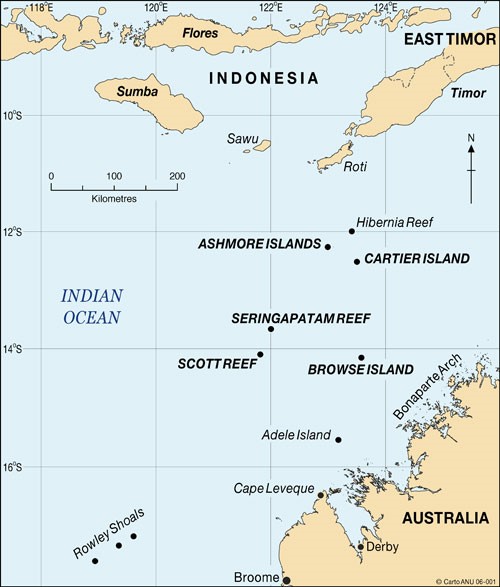North-West Shelf Islands

Few of the world’s coral reefs are still in pristine condition, but atolls on the North West Shelf are in great condition. The atolls of Australia’s North West Shelf are a fish diversity ‘hotspot’ and have many species that are not found elsewhere in Western Australia. If you want to see a pristine coral wilderness, then visit soon. There are concern about growing impacts from fishing, recreation and resource exploitation and coral bleaching. They can only be reached by live-aboard dive charter boat.
Rowley Shoal
Rowley Shoals Marine Park lies 300 kilometres west of Broome and consists of three coral atolls. The shoals are the remains of three volcanoes with nearly vertical sides rising from very deep water. Imperieuse Reef lagoon is about 20M deep with limited entry points. The only dry land is a small cay which is home to a metal lighthouse. Clerke Reef Lies 32kms to the north east. Mermaid Reef lies 24 kms north of Clerke Reef. It has a wide channel into the lagoons sheltered water. The sea breaks heavily over the fringing reef which is dry at low water but deep enough to allow entry to the lagoon, at least for smaller boats, at high water. From about 1977 charter boats operating from Broome began promoting deep sea fishing and scuba diving. The fish life is plentiful and tame and the underwater visibility very clear. 688 species of fish inhabit the Rowley Shoals including giant potato cod, maori wrasse, trevally, mackerel and tuna. The Shoals also support humpback whales, manta rays, hammerhead sharks and other large reef species. The Rowley Shoals offer a variety of diving for experienced divers, including high speed drift dives and outer reef wall dives. Visibility ranges from 20 to 60 metres and water temperatures are tropical. The best time of year to dive the Rowley Shoals is from October to December and the only way to dive these atolls is by liveaboard dive boat.
Wreck of the “Lively”
Around 1810 this British whaler went up onto the reef flat on the west side of Mermaid Reef. The anchors are visible on the reef flat at low water while wreckage is strewn down the reef including ballast stones, trypots, cannon and a few other items buried in the coral.
Scott Reef
10-30+M
A remote reef about 400 kms north of Broome that is rarely visited and requires a special charter. Scott Reef is divided into North Reef and South Reef by a large and deep lagoon. It is noted for its clear water and excellent pelagic fish life. It is considered similar to Rowley Shoal and is apparently well-liked by sea snakes. The South Scott Reef lagoon is sandy and very large and covers 300 km2. Unlike the outer reef areas of Mermaid Reef, South Scott Reef has a more gradual slope rather than vertical walls. This slope is often cut with gutters and is home to more soft and hard corals. North Scott Reef is sandier with areas full of big hard corals.
Seringapatam Reef
30m
This remote atoll with a diameter of 9kms lies just north of Scott Reef. It is rarely visited and requires a special charter to visit. It is similar to Scott Reef with a deep central lagoon.
Ashmore Reef
This reef is closer to Indonesia than Australia and requires a large liveaboard on a special charter to visit. There is a special diplomatic agreement allowing Indonesian traditional fishermen to continue to use zones on the shoal. It is basically a series of three sand cays surrounded by reef, but they are still pristine with clear water and amazing fish and corals. It is also an important turtle and seabird breeding area protected by a national nature reserve. Dugongs , mantas and sea snakes are commonplace,
Cartier Is
This area is close to Ashmore and is very similar.
